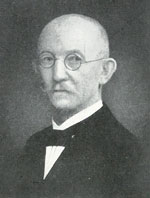Volume 27, Number 11—November 2021
Etymologia
Etymologia: Prototheca
Prototheca [pro″to-the′kə]
From the Greek proto- (first) + thēkē (sheath), Prototheca is a genus of variably shaped spherical cells of achloric algae in the family Chlorellaceae (Figure 1). Wilhelm Krüger, a German expert in plant physiology and sugar production, reported Prototheca microorganisms in 1894, shortly after spending 7 years in Java studying sugarcane (Figure 2). He isolated Prototheca species from the sap of 3 tree species. Krüger named these organisms as P. moriformis and P. zopfii, the second name as a tribute to Friedrich Wilhelm Zopf, a renowned botanist, mycologist, and lichenologist.
Protothecosis affects humans and wild and domestic animals, primarily causing mastitis in cows. Human protothecosis was reported in 1964 from a skin lesion in a farmer from Sierra Leone. There are increasing reports of infections in immunocompromised patients. Debates regarding Prototheca taxonomy persist.
References
- Davies RR, Spencer H, Wakelin PO. A case of human protothecosis. Trans R Soc Trop Med Hyg. 1964;58:448–51. DOIPubMedGoogle Scholar
- Dorland’s illustrated medical dictionary. 32nd ed. Philadelphia: Elsevier Saunders; 2012.
- Kano R. Emergence of fungal-like organisms: Prototheca. Mycopathologia. 2020;185:747–54.PubMedGoogle Scholar
- Krüger W. Brief characteristics of some lower organisms in the sap flow of deciduous trees [in German]. Hedwigia. 1894;33:241–66.
- Todd JR, Matsumoto T, Ueno R, Murugaiyan J, Britten A, King JW, et al. Medical phycology 2017. Med Mycol. 2018;56(suppl_1):S188–204. DOIPubMedGoogle Scholar
Figures
Cite This ArticleOriginal Publication Date: September 28, 2021
Related Links
Table of Contents – Volume 27, Number 11—November 2021
| EID Search Options |
|---|
|
|
|
|
|
|


Please use the form below to submit correspondence to the authors or contact them at the following address:
Rüdiger D. Ollhoff, Programa de Pós-Graduação em Ciência Animal da Pontifícia Universidade Católica do Paraná, Rua Imaculada Conceição, 1155 Prado Velho, Curitiba 80215 901, Paraná, Brazil
Top